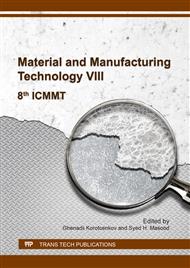p.105
p.110
p.117
p.122
p.128
p.135
p.141
p.148
p.155
Non-Isothermal Curing Kinetics of a Modified Benzoxazine Resin System Suitable for Hot-Melt Prepreg Preparation
Abstract:
Non-isothermal DSC was used to study the cure kinetics of a flame-retardant benzoxazine resin system (BZ501-1) suitable for hot-melt prepreg preparation. The variation of activation energy with conversion for BZ501-1 system was investigated by using Flynn-Wall-Ozawa method, and the average value of activation energy obtained from this method was 100.5 kJ/mol. After that, the model function that depends on the reaction mechanism for the non-isothermal cure of BZ501-1 system was determined by Málek method, and the result showed that Šesták-Berggren model can generally simulate well the reaction rate. Finally, the isothermal curing behavior of BZ501-1 at 200 °C was predicted by using the obtained rate equation, and the result showed that there was no significant difference between the experiment conversions and the predicted ones. The predicted results at different temperatures indicated that the curing rate increased gradually with increasing the curing temperature.
Info:
Periodical:
Pages:
128-134
Citation:
Online since:
October 2017
Authors:
Price:
Сopyright:
© 2017 Trans Tech Publications Ltd. All Rights Reserved
Share:
Citation:


